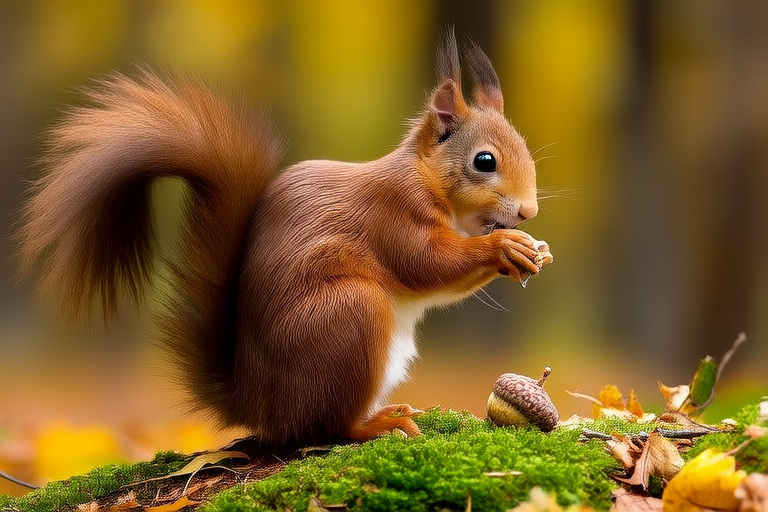The Adorable and Mischievous World of Squirrels
Squirrels are one of the most ubiquitous and beloved animals in both urban and natural environments. These small mammals are known for their playful antics, sharp intelligence, and crucial roles in maintaining ecological balance. With over 200 species worldwide, from the tiny African pygmy squirrel to the large Indian giant squirrel, squirrels come in various shapes and sizes, each adapted to its unique habitat. This article explores the behaviors, habitats, and quirky traits of squirrels, emphasizing their adorable and mischievous nature.
Daily Routines and Interactions Within Their Environment
Each day, squirrels embark on a series of activities that keep them busy and engaged. They spend much of their time foraging for food, which primarily consists of nuts, seeds, fruits, and occasionally insects. Squirrels have an impressive ability to remember where they’ve hidden their food, a trait that helps them survive during harsh winters. Their keen sense of smell and spatial memory allow them to retrieve stored food with remarkable accuracy.
Aside from foraging, squirrels engage in social behaviors that include playing, grooming, and marking their territories. They are highly territorial, especially during breeding seasons, and will often chase off intruders or mark their territory with scent glands. Despite their territorial nature, squirrels can be surprisingly social, forming loose-knit communities that interact through vocalizations and body language.
Unique Survival Tactics
Squirrels have developed several unique survival tactics to thrive in their environments. One of the most notable is their ability to cache food, which involves burying nuts and seeds in various locations throughout their territory. This behavior not only ensures a steady supply of food but also aids in seed dispersal, contributing to forest regeneration. Some studies suggest that squirrels may even intentionally plant trees by forgetting where they’ve hidden certain seeds.
In addition to caching food, squirrels have evolved physical adaptations that enhance their survival. Their bushy tails serve multiple purposes, including balance, communication, and warmth. When startled, squirrels often flick their tails to warn others of potential danger. Their sharp claws and strong limbs enable them to climb trees with ease, providing protection from ground predators and access to high-up food sources.
Interesting Facts About Different Squirrel Species
While all squirrels share some common traits, each species has unique characteristics that set it apart. For instance, the red squirrel, native to Europe and parts of Asia, is known for its distinctive reddish-brown fur and tufted ears. In contrast, the gray squirrel, found in North America and introduced to other parts of the world, has a more uniform gray coat and lacks ear tufts. The flying squirrel, though not capable of true flight, can glide between trees using a membrane of skin stretched between its limbs.
Another fascinating species is the ground squirrel, which spends much of its time on the ground rather than in trees. Ground squirrels are highly social and live in colonies, communicating through a variety of vocalizations and body movements. Some ground squirrels hibernate during winter, while others remain active year-round. The California ground squirrel, for example, is known for its ability to defend itself against rattlesnakes by mimicking the snake’s rattle sound.
The Role of Squirrels in Ecosystems
Squirrels play a vital role in maintaining the health and diversity of ecosystems. As seed dispersers, they help plants reproduce and spread across landscapes. By burying seeds and sometimes forgetting where they’ve hidden them, squirrels inadvertently create new growth areas. Additionally, squirrels contribute to nutrient cycling by consuming fungi and redistributing spores throughout their habitat.
Moreover, squirrels serve as prey for numerous predators, including birds of prey, foxes, and snakes. Their presence in an ecosystem indicates a healthy balance, as their abundance or scarcity can affect predator populations and overall biodiversity. In urban settings, squirrels also provide entertainment and education for people, fostering appreciation for nature and encouraging conservation efforts.
Challenges Faced by Squirrels
Despite their adaptability, squirrels face numerous challenges in both urban and natural environments. Habitat loss due to deforestation, urbanization, and agricultural expansion poses a significant threat to many squirrel species. As forests shrink, squirrels must compete for limited resources, leading to increased stress and mortality rates. In urban areas, squirrels are often exposed to dangers such as traffic, pollution, and human-related hazards like traps and poisons.
Climate change further complicates the lives of squirrels, altering weather patterns and affecting food availability. Warmer temperatures may lead to mismatches between when squirrels emerge from hibernation and when food sources become available, resulting in nutritional deficiencies and reduced reproductive success. Conservation efforts aimed at preserving habitats and mitigating climate impacts are essential for ensuring the survival of squirrel populations.
Coexisting Peacefully with Squirrels
Humans can coexist peacefully with squirrels by adopting practices that promote mutual respect and understanding. In urban settings, providing bird feeders and bird baths can attract squirrels without encouraging nuisance behaviors. Planting native trees and shrubs offers squirrels natural food sources and shelter, reducing the need for them to rummage through garbage or invade homes. Additionally, securing trash bins and compost piles prevents squirrels from accessing human food waste, minimizing conflicts.
In natural environments, supporting conservation initiatives and participating in citizen science projects can help monitor squirrel populations and address threats. Educating oneself and others about the importance of squirrels in ecosystems fosters appreciation for these creatures and encourages responsible stewardship of shared spaces. By embracing coexistence, humans can enjoy the company of squirrels while ensuring their long-term survival.
Conclusion
The world of squirrels is full of wonder and intrigue, offering endless opportunities for discovery and enjoyment. From their playful antics to their crucial roles in ecosystems, squirrels captivate our imagination and inspire admiration. By understanding their behaviors, habitats, and challenges, we can better appreciate the value of these charming creatures and work towards creating harmonious relationships with them. Whether in urban parks or vast wildernesses, squirrels enrich our surroundings and remind us of the beauty and complexity of nature.
